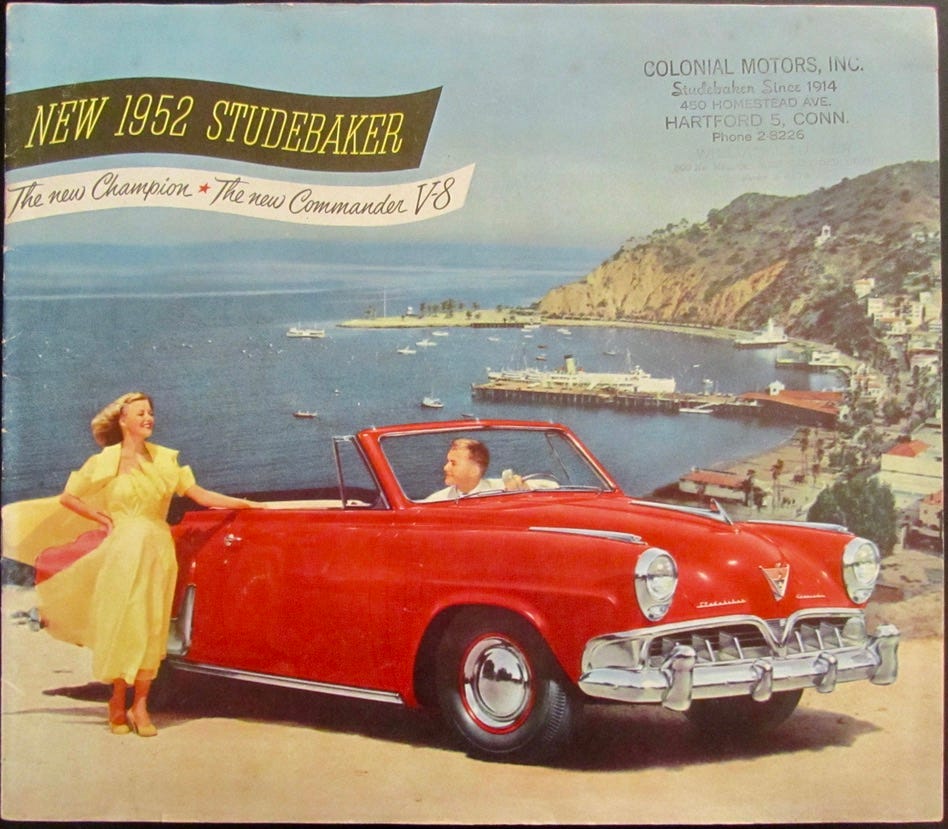Studebakers
Real Objects in Fiction
I HAD FIGURED that if anyone could teach me the times tables quickly, it was Mr. Beaker. I was right. Mr. Beaker instituted a crash program in the times tables that very evening. He and Eliza drove up in a gleaming new Starliner, which Mr. Beaker had bought for Eliza’s birthday.
Little Follies, “The Girl with the White Fur Muff”

I would say that the moment an object appears in a narrative, it is charged with a special force and becomes like the pole of a magnetic field, a knot in the network of invisible relationships. The symbolism of an object may be more or less explicit, but it is always there. We might even say that in a narrative any object is always magic.
Italo Calvino, Six Memos for the Next Millennium: “Quickness”
Drinking: Cocktails, Old Fashioned
My father reached into the refrigerator and took out a couple of beers. He opened them and handed one to Mr. Beaker. “Would you like a beer, Eliza?” he asked.
“Yes, thanks, Bert,” said Eliza.
“How about you, Ella?” my father asked.
“Oh, not a beer,” said my mother. She turned to Eliza and said, “Let’s have something more fun than a beer.” She turned back to my father. “Make us an Old Fashioned, Bert,” she said. My father sighed and began working on a couple of Old Fashioneds.Little Follies, “The Girl with the White Fur Muff”
Thinking: Focusing the Attention
“Peter,” he said, resting a hand on my shoulder, “if you’re going to learn these by next week, you’re going to have to focus your attention on the times tables and nothing else. Do you understand what I mean?”
“Yes,” I said.
“We have to be sure that you’re going to focus your attention on the times tables and nothing else, do you understand?”
“No,” I said.Little Follies, “The Girl with the White Fur Muff”
Mr. Beaker nodded in my direction. “It’s . . . a matter of focusing the attention.” He raised his voice. “‘True genius,’ it has been said, ‘lies in the art of focusing the attention.’” He paused to let that sink in, and Eliza took advantage of the pause at once.
“I don’t know about that,” she said. “It seems to me that a true genius ought to be able to keep a lot of balls in the air at once.”
There was a pregnant silence. Gumma, Guppa, and my father stood still, unbreathing. The kittens and I stopped romping. We all looked at Mr. Beaker.
“No, no,” he said. “You have an example right in front of you.” He pointed his pipestem at me. “Now if little Peter there were to narrow his focus, concentrate on and pursue only one kitten, he could catch it and keep it. … Remember this scene,” he said. “Here we see Peter’s life, in miniature: this pursuing now one notion (or kitten), now another, this inability to concentrate entirely on one thing (or kitten) for fear that the others will get away, though really he might just as well pursue any one of them as all of them, for the kittens, as you and I can see at a glance, are so like one another as to be indistinguishable, each just a variation on the theme ‘Black Kitten.’” He chuckled and jotted something in a little leather-covered notebook. “Do you follow me?” he asked.Little Follies, “My Mother Takes a Tumble”
[more to come on Tuesday, November 16, 2021]
Have you missed an episode or two or several?
You can begin reading at the beginning or you can catch up by visiting the archive or consulting the index to the Topical Guide.
You can listen to the episodes on the Personal History podcast. Begin at the beginning or scroll through the episodes to find what you’ve missed.
At Apple Books you can download free eBooks of “My Mother Takes a Tumble,” “Do Clams Bite?,” “Life on the Bolotomy,” “The Static of the Spheres,” and “The Fox and the Clam,” the first five novellas in Little Follies.
You’ll find an overview of the entire work in An Introduction to The Personal History, Adventures, Experiences & Observations of Peter Leroy. It’s a pdf document.



